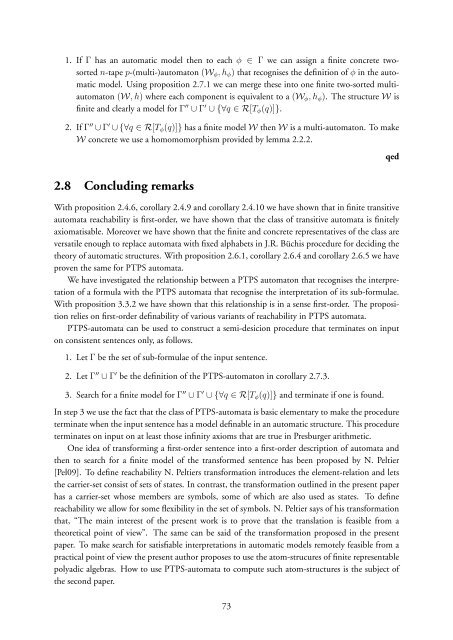On the methods of mechanical non-theorems (latest version)
On the methods of mechanical non-theorems (latest version)
On the methods of mechanical non-theorems (latest version)
You also want an ePaper? Increase the reach of your titles
YUMPU automatically turns print PDFs into web optimized ePapers that Google loves.
1. If Γ has an automatic model <strong>the</strong>n to each φ ∈ Γ we can assign a finite concrete twosorted<br />
n-tape p-(multi-)automaton (W φ , h φ ) that recognises <strong>the</strong> definition <strong>of</strong> φ in <strong>the</strong> automatic<br />
model. Using proposition 2.7.1 we can merge <strong>the</strong>se into one finite two-sorted multiautomaton<br />
(W, h) where each component is equivalent to a (W φ , h φ ). The structure W is<br />
finite and clearly a model for Γ ′′ ∪ Γ ′ ∪ {∀q ∈ R[T φ (q)]}.<br />
2. If Γ ′′ ∪ Γ ′ ∪ {∀q ∈ R[T φ (q)]} has a finite model W <strong>the</strong>n W is a multi-automaton. To make<br />
W concrete we use a homomomorphism provided by lemma 2.2.2.<br />
qed<br />
2.8 Concluding remarks<br />
With proposition 2.4.6, corollary 2.4.9 and corollary 2.4.10 we have shown that in finite transitive<br />
automata reachability is first-order, we have shown that <strong>the</strong> class <strong>of</strong> transitive automata is finitely<br />
axiomatisable. Moreover we have shown that <strong>the</strong> finite and concrete representatives <strong>of</strong> <strong>the</strong> class are<br />
versatile enough to replace automata with fixed alphabets in J.R. Büchis procedure for deciding <strong>the</strong><br />
<strong>the</strong>ory <strong>of</strong> automatic structures. With proposition 2.6.1, corollary 2.6.4 and corollary 2.6.5 we have<br />
proven <strong>the</strong> same for PTPS automata.<br />
We have investigated <strong>the</strong> relationship between a PTPS automaton that recognises <strong>the</strong> interpretation<br />
<strong>of</strong> a formula with <strong>the</strong> PTPS automata that recognise <strong>the</strong> interpretation <strong>of</strong> its sub-formulae.<br />
With proposition 3.3.2 we have shown that this relationship is in a sense first-order. The proposition<br />
relies on first-order definability <strong>of</strong> various variants <strong>of</strong> reachability in PTPS automata.<br />
PTPS-automata can be used to construct a semi-desicion procedure that terminates on input<br />
on consistent sentences only, as follows.<br />
1. Let Γ be <strong>the</strong> set <strong>of</strong> sub-formulae <strong>of</strong> <strong>the</strong> input sentence.<br />
2. Let Γ ′′ ∪ Γ ′ be <strong>the</strong> definition <strong>of</strong> <strong>the</strong> PTPS-automaton in corollary 2.7.3.<br />
3. Search for a finite model for Γ ′′ ∪ Γ ′ ∪ {∀q ∈ R[T φ (q)]} and terminate if one is found.<br />
In step 3 we use <strong>the</strong> fact that <strong>the</strong> class <strong>of</strong> PTPS-automata is basic elementary to make <strong>the</strong> procedure<br />
terminate when <strong>the</strong> input sentence has a model definable in an automatic structure. This procedure<br />
terminates on input on at least those infinity axioms that are true in Presburger arithmetic.<br />
<strong>On</strong>e idea <strong>of</strong> transforming a first-order sentence into a first-order description <strong>of</strong> automata and<br />
<strong>the</strong>n to search for a finite model <strong>of</strong> <strong>the</strong> transformed sentence has been proposed by N. Peltier<br />
[Pel09]. To define reachability N. Peltiers transformation introduces <strong>the</strong> element-relation and lets<br />
<strong>the</strong> carrier-set consist <strong>of</strong> sets <strong>of</strong> states. In contrast, <strong>the</strong> transformation outlined in <strong>the</strong> present paper<br />
has a carrier-set whose members are symbols, some <strong>of</strong> which are also used as states. To define<br />
reachability we allow for some flexibility in <strong>the</strong> set <strong>of</strong> symbols. N. Peltier says <strong>of</strong> his transformation<br />
that, “The main interest <strong>of</strong> <strong>the</strong> present work is to prove that <strong>the</strong> translation is feasible from a<br />
<strong>the</strong>oretical point <strong>of</strong> view”. The same can be said <strong>of</strong> <strong>the</strong> transformation proposed in <strong>the</strong> present<br />
paper. To make search for satisfiable interpretations in automatic models remotely feasible from a<br />
practical point <strong>of</strong> view <strong>the</strong> present author proposes to use <strong>the</strong> atom-strucures <strong>of</strong> finite representable<br />
polyadic algebras. How to use PTPS-automata to compute such atom-structures is <strong>the</strong> subject <strong>of</strong><br />
<strong>the</strong> second paper.<br />
73
















